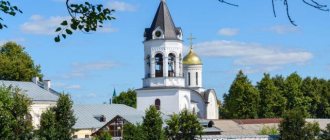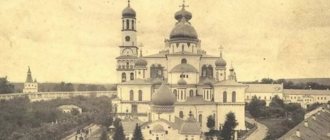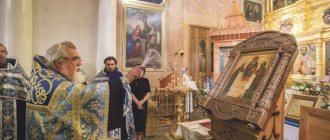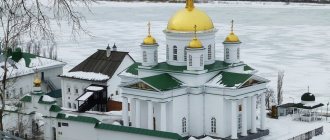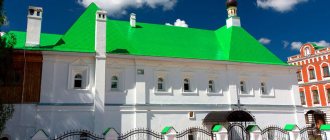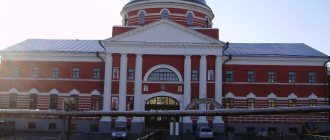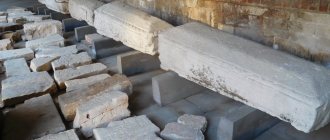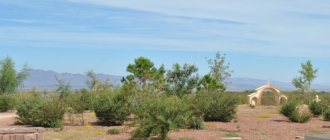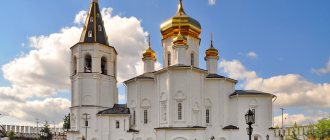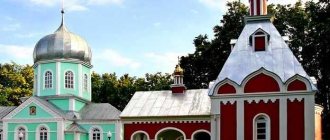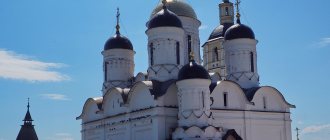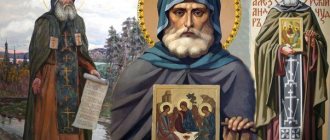The New Athos Simon-Kananitsky monastery is located in Abkhazia, on Mount Athos, at an altitude of 75 meters above sea level. It was founded in 1875 by monks who came from Greece. This is one of the largest religious centers in the entire Caucasus, a place of pilgrimage and one of the popular tourist attractions of Abkhazia. Since 2011, the monastery has belonged to the Abkhazian Orthodox Church. It attracts believers from all over the world and tourists with its history and beautiful landscapes: the monastery is surrounded by gardens, parks and is located on the Black Sea coast.
© Julia Alisova
History of the monastery
The New Athos Monastery was built in 1875 by Greek monks who came from Old Athos. Hence the name of the monastery - New Athos. The construction was supported and financed by Russian Emperor Alexander III.
Back in the 11th century in Greece, monks built the Panteleimon Monastery, also known as Rossikon and traditionally considered “Russian”. Over time, the Greek clergy changed their attitude towards the presence of Russian monks and the monastery was going to be closed.
Archimandrite Macarius began to seek support from Russia and asked the Russian emperor to allocate a plot of land for the construction of a new monastery. Initially, land in the Solokh Aul area in Sochi was considered for these purposes (now the Krestova Hermitage monastery is located here). But in 1874, another place was chosen at the foot of Mount Athos in Abkhazia, where construction of the New Athos Monastery began.
The New Athos Monastery in Abkhazia is located on the slope of a mountain, so the monks faced many difficulties during construction. It was necessary to remove some of the soil from the mountain to create a level area for construction.
The monks loaded earth and stones into bags, which they lowered down on their shoulders. Climbing up the mountain and descending hundreds of times, they trodden a path soaked with sweat. Later it was called the path of sinners.
Construction was carried out actively, but three years after the start of construction the monks were prevented by the Russian-Turkish War. Work was suspended, and the unfinished monastery was plundered. Construction resumed a year later. And the monastery was completed only in 1900.
Even before the opening of the monastery, Emperor Alexander III came here, who donated significant sums for construction and presented the monastery with chimes, which were placed on a high bell tower.
The monastery is named after Simon the Canaanite, who lived and preached Christianity in Abkhazia in the 1st century AD. He was killed by Roman pagans in 55 AD. Later, the body was buried under the altar of the Temple of Simon the Canaanite (now defunct).
After the opening of the New Athos Monastery in Abkhazia, thousands of pilgrims and monks came here every year. By the beginning of the twentieth century, the monastery was the largest monastery on the Black Sea coast and numbered more than 2,000 monks.
However, after the Great October Revolution, the monastery began to decline. On the site of the monastic cells, they organized a camp site for the recreation of Soviet workers, and on the site of the abbot’s house, they built Stalin’s dacha (one of five Abkhaz dachas). And during the Georgian-Abkhaz war, a military hospital was located here.
The New Athos Monastery in Abkhazia was returned to believers only in 1994. They began to restore it and put it in order.
The heyday of the monastery
Before the revolution, the monastery experienced the dawn of its existence. More than 700 people live here among the monastic brethren alone. Life goes according to the strict Athonite Rule: prayer and work. And we had to work really tirelessly. I would compare the Simono-Kananitsky monastery to a small kingdom-state, which could well provide not only for itself, but also for numerous pilgrims, wanderers, workers, and helped the poor local population. And, of course, the most important thing for all those who came here was the provision of spiritual assistance to them by experienced monks.
At the monastery there was a school for boys, a pharmacy, 2 hospitals, book and icon shops, a rich library and a bookbinding workshop, a stud farm, apiaries, and a rich vegetable garden. The inhabitants were real experts in various areas, putting their “golden skillful hands” to work in lathes, carpentry, foundries, blacksmiths, refectories, and many other craft areas. There was even a watch repair workshop in the monastery.
By the way, about the clock! The Russian Emperor Alexander III made an amazing gift for the monastery. He donated a musical chime clock for the 50-meter bell tower. Another unique gift from the Emperor was a steam locomotive. Yes Yes! The monastery, as befits a real kingdom-state, even had its own small railway line. As for the memorable steam locomotive, it is still included in the collection of sights of New Athos. Well, again, in the “top” of indispensable places for photography, but getting to it is not easy, because it is located right at the very top of Mount Athos.
In addition to the iron narrow-gauge railway, the monastery also had cable cars. The list of wonders would be incomplete without mentioning the olive groves and gardens of lemons, oranges and tangerines never seen before in these parts!
And I myself was surprised to learn that the Abkhaz tangerines, so familiar to Russians, sold in kiosks and shops, were not at all so familiar to Abkhazia itself. And they appeared here only thanks to the Afoniatians, took root and spread throughout the Caucasus. From time immemorial, Russian monasteries have been famous for their charity. The New Athos Simon-Kananitsky monastery becomes not only the spiritual center of Orthodoxy in the Caucasus, but also conducts large missionary activities. In addition to the school where 50 Abkhaz orphan boys studied, help was provided here to all those in need. Here they could feed, warm, encourage, heal, and support with spiritual words.
At any time of the day you could knock on the gates of the monastery, and you would be greeted hospitably, and if necessary, they would also provide financial assistance.
I, a St. Petersburg resident, was interested to know the fact that before the revolution this monastery had its own courtyard in St. Petersburg on Zabalkansky Avenue, which was also the courtyard for the Greek Athonite Monastery of St. Panteleimon.
What to see in the New Athos Monastery
Architecture
The architecture of the New Athos Monastery differs from traditional Russian church architecture. The monastery in Abkhazia was built according to neo-Byzantine canons. There are six churches on the territory of the monastery: the Church of the Ascension of the Lord, Panteleimon Cathedral, the Church of St. Apostle Andrew the First-Called, the Church of the Icon of the Mother of God “Deliverer”, the Church in honor of the Venerable Fathers of Athonite, the Church of the Martyr Jerome.
In the center of the monastery buildings is the Panteleimon Cathedral. This is the most significant building of the complex. The high bell tower, located on the left side of the Panteleimon Cathedral, is decorated with frescoes by the Volga masters, the Olovyannikov brothers, and under the dome of the bell tower there is a clock donated by Alexander III.
Frescoes
The beautiful painting inside the temple was done by Palekh masters at the beginning of the 20th century. Unfortunately, the painting is now badly damaged and requires restoration.
Icons
The New Athos Monastery in Abkhazia stores few icons and the main ones are several:
- Icon of the Mother of God “Deliverer” with St. the apostle Simon the Canaanite and the great martyr and healer Panteleimon (late 19th - early 20th centuries)
- Icon of St. Panteleimon with his life (1896)
- Icon of the Mother of God “Anakopia” (2005)
- New image of the Pitsunda Icon of the Mother of God (2009)
Wooden benches
Many visitors to the New Athos Monastery in Abkhazia are surprised to see rows of wooden benches standing in the center of the temple. After all, according to the canons of the Russian Orthodox Church, people listen to the service while standing, not sitting. So why are there benches in an Orthodox church?
The fact is that in the New Athos Monastery Divine services are performed in accordance with the Church Charter of the monasteries of Holy Mount Athos and the traditions of the Eastern Orthodox Churches.
During the Divine Service, men stand or sit on the right side of the Cathedral, women, respectively, on the left side
Opening hours and rules for visiting the monastery
The New Athos Monastery is open to tourists and pilgrims from Wednesday to Sunday, from 12:00 to 18:00. Entrance to the territory is free. Voluntary donations are accepted.
You can visit all the temples of the complex. You can take pictures inside without flash. Since the monastery is active, entry into its territory is recommended in modest clothing, with covered shoulders and knees, and for women with a covered head. If you don’t have a scarf or long skirt with you, they will be provided free of charge at the entrance. Services are conducted in three languages - Abkhazian, Greek and Russian.
On the territory of the monastery there are trading tents where you can buy water, food and souvenirs. The products of the monastery farm are also sold there - honey, herbal brooms, jam, etc.
How to get there
By public transport
It is necessary to cross the Psou border post. Once on the territory of Abkhazia, you can use a regular bus that goes from the border to New Athos or Sukhum. Monastery address: Republic of Abkhazia, New Athos (Anakopia), Monastery of the Holy Apostle Simon the Canaanite.
By personal car
After crossing the border you need to go to New Athos. When turning from the highway, the New Athos Monastery will be visible from the road. He does not have an exact address. Landmark – the top point of the street. Resort.
As part of the excursion
An excursion to the New Athos Monastery in Abkhazia is one of the most popular. You can go there as part of a group tour or take a private tour with a private guide.
Abbots' conflict
A difficult situation arose in the leadership of the monastery in the 2010s.
Pilgrims and ordinary tourists are far from the problems and disputes unfolding in the monastery. Therefore, the number of different travelers visiting the holy place has not decreased. Now the highest clergy of the Orthodox Church of Russia views the leadership of the monastery as schismatic. Since the spring of 2011, the Abkhaz Church has been governed by a council headed by Priest Vissarion, who advocates close ties with the Moscow Patriarchate. In the monastery, power belongs to the Metropolitanate of Abkhazia. The head of the council is Dorofey. The mentor of the monastery is David Sarsania. Events developed as follows:
- in April 2011, Kirill, the Moscow Patriarch, sent a new abbot, Ephraim, to the monastery; this was done at the request of Vissarion;
- the patriarch's decision caused discontent and protest from Andrei, the former abbot;
- he wrote an open letter to the patriarch; in it, the hieromonk insisted on convening a general meeting, which was supposed to discuss the controversial issue and make a decision;
- no actions were taken to resolve the conflict;
- in October 2013, David, a supporter of Andrei and Dorotheus, became the rector of the monastery.
In 2022, the situation remains tense, although this does not affect the tourist flow.
What to see nearby
The territory of New Athos is densely dotted with attractions. Therefore, when you arrive at the New Athos Monastery, be sure to take time to explore other equally interesting sights.
Here is a list of places to visit nearby:
- New Athos Cave
- Cell of Simon the Canaanite
- Man-made waterfall on the Psyrtskha River
- Stalin's dacha
- Railway station on the Psyrtskha River
- Temple of Simon the Canaanite
- Historical Museum
- Swan Lake in Primorsky Park
You might be interested
Sightseeing tour of Sochi
A sightseeing tour of Sochi is one of the most popular and popular excursions.
Coming to Sochi v.. Read more
Excursion to the yew-boxwood grove
An individual excursion to the yew-boxwood grove begins with the picturesque Devil's Gate canyon.
Sky.. Read more
Individual excursion to New Athos. Abkhazia
What you will see on an individual excursion to New Athos Gagry Caves of New Athos Novoathon..
Read more
Excursion to the Olympic Park with fountain show
An excursion to Krasnaya Polyana and the Olympic Park can be booked here. An excursion to the Olympic Park..
Read more
LAKE RITSA, ABKHAZIA
Lake Ritsa in Abkhazia is the most famous and popular lake.
This lake is located high in the mountains, on... Read more
SOCHI CIRCUIT DRIVE IN THE OLYMPIC PARK
History of the creation of the Sochi AutodromeOne of the structures of the Olympic Park is the Sochi Autodrome.
.. Read more
ABKHAZIAN WINE. HOW TO DISTINGUISH AN ORIGINAL FROM A FAKE. PART 1
Abkhazian wines have been known to Russian consumers since the times of the Soviet Union.
After all,... Read more
Celebration of the consecration of the main altar
On September 28, 1900, the consecration of the main altar of the cathedral church of the holy healer Panteleimon took place. More than 20 thousand people gathered for the grandiose celebrations. And there was something to marvel at! Against the malachite background of Mount Athos, the sun generously illuminated the golden crosses and domes of the monastery churches. The view was amazing! On one side the monastery was embraced by a pine grove, and at a distance lay a marvelous tropical garden. From the sea to the monastery, pilgrims walked along a stone-paved road through a row of pyramidal cypress trees.
This road was called the Tsar's Alley in honor of the procession along it during the consecration ceremony of the monastery of the imperial family. At the revived temple of Simon the Canaanite, the monks built a beautiful waterfall. And today this is one of the “branded places” for those who like to take pictures, and, of course, take “selfies”.
By the way, a so-called “natural refrigerator” was built directly under the waterfall, located in rooms specially designated for this purpose. And next to 1901, a real hydroelectric power station was built, which made it possible to have lighting for the entire monastery complex.
